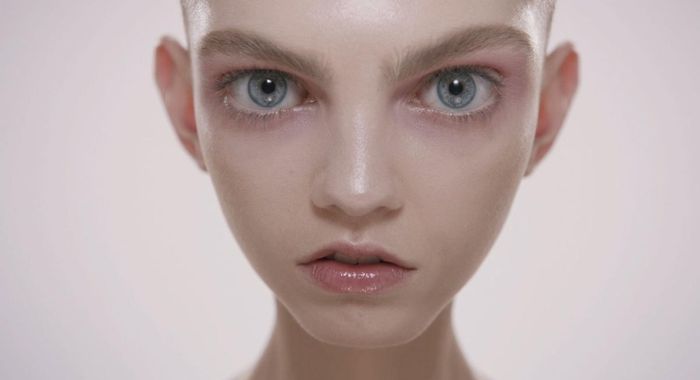Article originally published by i-D Magazine, written by Amelia Abraham
Kai and Casil and Elie, three trans people, talk about the limitations of gender and what beauty means to them.
“Getting ready can take me anything from a few minutes to a few hours,” says Kai Isaiah Jamal, of his morning routine. “Yesterday my moustache wasn’t going on properly, and I had a two-hour meltdown.”
Kai is a trans visibility activist and poet-performer living in Leeds. When he gets up in the morning, his beauty regime is as follows: first, he showers -- the bathroom light was broken for a while, which made this feel easier, since he didn’t have to see his body in the mirror. Then he will pencil in his moustache to accentuate it, put on a breast binder, and put a packer in his pants. “Sometimes I’ll take like five minutes to position it,” he laughs, “to make sure I’m not walking around with what looks like a semi-erect penis.” Then he chooses his outfit -- no clingy materials, just baggy T-shirts or shirts.
Kai photographed by Amelia Fern
One thing that helps improve Kai’s confidence to leave the house is taking selfies. “It’s an affirmation thing,” he explains. “When I first started to transition, people told me to stand in the mirror and say positive things, but it felt so forced and unnatural. I realised that taking photos, manipulating the lighting, the angle, it was a way to feel like, if I see myself like this, then hopefully someone else, someplace else will see me like this.”
Kai talks about the emotions that come with his daily regime because he wants other trans men to feel like they’re not alone in whatever they’re going through. Seeing guys like Cayden Carterdocumenting the tougher parts of their day to day dysphoria on social media, or writer and activist TIQ posting about being a trans father, have helped Kai. On Instagram accounts like Kayden’s, trans men offer each other advice in the comment sections: if you’re still getting your period, do something nice that week, like getting your haircut, for instance, or else take off your binder a little early.
In the mainstream media, discussions about what it’s like to transition from female to male are still rare, however. The visibility of trans women and improved reporting around the violence that trans women face has helped to raise the profile of trans female struggles -- particularly beauty standards around “passing”, the interplay between your safety and whether or not you look cisgender. These are important conversations, Kai says, as trans women are some of the most vulnerable in society. But trans men are often left out of the conversation, which can feel alienating if you are one.
The good news is, trans men like Kai are trying to change this. Casil McArthur is another pushing for visibility. A trans male model who at 19 has already been booked by Calvin Klein, starred in a GAP campaign and been shot by Steven Meisel. He’s been modelling since he was 10, realising around the age of 13 that he wasn’t totally comfortable with his gender. As a teen Casil started cosplaying as a male princess and someone told him that he was the most beautiful boy they’d ever seen, the first time that he’d been called beautiful and it actually meant something to him. At 16, tired of the strangling feeling of being forced to present as a girl, Casil quit modelling, started taking testosterone, and became a model again, this time as himself -- or as he puts it, “a bomb-ass male model!”
“I don’t think any make-up or clothing should be restricted to one gender. And I truly believe that people who are mad at guys dressing femininely are just guys who wish they could do it themselves but who haven’t been raised with the ability to feel comfortable about it.” - Casil McArthur
Talking to Kai and Casil about what beauty means to them throws up very different responses. For Casil, transitioning to male gave him the confidence he needed to experiment more with the way he looks. “I always loved make-up and feminine clothing, but the problem is, when I was younger I couldn’t enjoy those things for myself unless it was for a photoshoot, because in my regular life I felt so uncomfortable.” Now Casil wears mascara and eyeliner most days to accentuate his eyes and make him feel pretty, as well as pink wigs and pink dresses.
Sometimes Casil’s make-up or wig choices result in his being misgendered, or people assuming he’s trans female, but personally he tries to take that as a compliment. “I had a lot of insecurity at the beginning when everything was still feminine -- my hips, my arms, my facial features -- but now I know who I am and no-one can say anything at this point to make me upset with myself,” he says. “I don’t think any make-up or clothing should be restricted to one gender. And I truly believe that people who are mad at guys dressing femininely are just guys who wish they could do it themselves but who haven’t been raised with the ability to feel comfortable about it.”
Kai however, talks about how the weight of certain masculine beauty standards -- particularly black male beauty standards -- have made him feel like he needs to look tough and not effeminate. When first transitioning, he studied men for a long time, “like a stalker”, he jokes. “How they ate, how they sat, how they walked. To me, these were the things that would make me passable.” But the pressure to pass isn’t just about looking a certain way, it’s about safety, like when he goes into male toilets, for example. “There are so many complexities,” Kai explains, “I’ve got a thing about my hands being feminine, so getting on public transport, I don’t like to hold the rails.”
For full article, see here.

